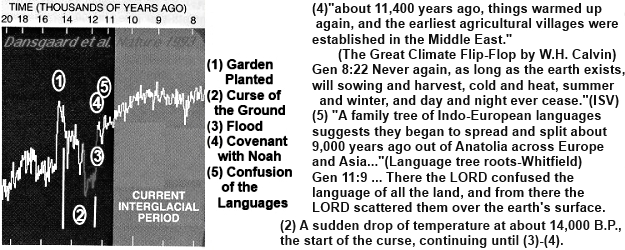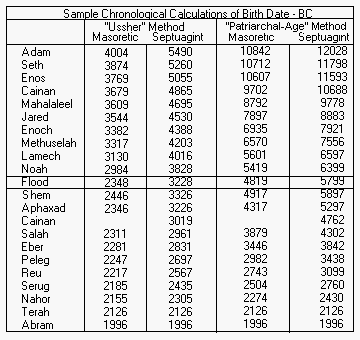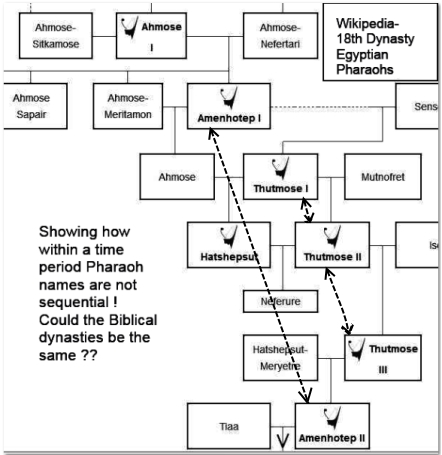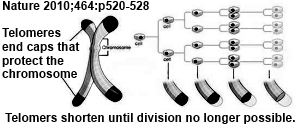Nearly all who know about the Biblical Scriptures have at one time wondered when Adam was created and when was the flood! Seems like a simple enough question, just add up the numbers in Genesis 5 and Genesis 11 and you have the dates; right? Unfortunately it is not that simple! When one adds up the numbers it is usually assumed that the genealogies given are a continuous listing of fathers and the year and name of the first direct son, and that there is only one son of that name. We are told that each had many offspring, for example a tradition is that Adam and Eve had 33 sons and 23 daughters. The ancient Hebrew wording has no designation for grandfather, great grandfather, grandson, great grandson, etc.. The son mentioned could possibly be a son who some how distinguished them self or was the most favored son and not the first son. We all know of the custom in some families to have the same name for many generations and use designations like senior and junior or designations like I, II, III, etc.. (In 12th Dynasty Egypt there were 4 kings named Amenem-het, 18th Dynasty had 4 Thutmoses and 4 Amenhoteps, and there were 11 Ramesses in the 19th and 20th Dynasties. Assyria had 4 kings named Shal-maneser. And in the Scriptures there were 2 Abimelech, 2 Jabin and 2 Enoch.) And to further complicate the matter we have number differences between the Masoretic text and the Septuagint translation due to possible transcription or translation differences. And also the Masoretic text omits Cainan ( or Kainan ) which the Septuagint includes in 11:12-13. However, Luke also includes Cainan in his genealogy which seems to support the Septuagint translation.
Therefore, depending upon the preferred translation and interpretations of key passages by those doing the calculations we have greatly different end results. For the creation of Adam for instance different scholars have given us dates of 4,004 BC, 5,490 BC, 10,842 BC, and 12,028 BC as a few examples. And for the date of the flood 2,348 BC, 3,228 BC, 4,819 BC, and 5,799 BC are a few examples. ( see Appendix A ) The numbers from the Septuagint provide later dates than those of the Masoretic text. For millenniums the standard way was to assume that there was a direct father-son relationship for each name given and that the year given was the birth year of the direct son. From these calculations we get the lower values for the creation of Adam and the flood. But many students were not fully satisfied with these values since the archaeological evidences being uncovered did not seem to confirm these early dates. Then along came Harold Camping who proposed that unless it was obvious from the text that there was a direct father-son relationship, there was instead an ancestral relationship with the named descendant being born during the year of the death of the patriarch. This method gives the much later dates and seems to correlate more closely to the information being presented by archaeologists. But again these calculations did not seem to satisfy many since it deviated greatly from the standard interpretations of the Hebrew text.
Why it is NOT proper to "add up" the genealogies
of Genesis chapter 5 and chapter 11 !
1) "Every word of God is pure; He is a shield unto them that put their trust in him.
2) The difficulties with assuming one knows how to "add up" the genealogies
Add thou not unto His words, lest He reprove thee, and thou be found a liar." Proverbs 30:5-6a) NO where does the Bible "add up" the genealogies !
b) Or say to "add up" the genealogies !
c) Nor hint at how they should be "added up"!
d) Those that do so must assume that they know how the ancients did genealogies ! But, in fact they often used different rules than just a strict biological father to son lineage. (See Appendix A below.)
a) Luke adds a name: In Luke 3:35-36 he includes a Cainan between Salah and Arphaxad. Genesis 11:12-13 includes No name between Arphaxad and Salah. Cainan is the son of Arphaxad and Shelah is the son of Cainan according to Luke; while in the Chronicle this name is not found. However, in Hebrew traditional lineage this name can be found, it is found in the Greek Septuagint Version. Why was this name not in our Bible and found in Septuagint and tradition? By some Hebrew traditions if a person died when they are very young before they have a chance to establish a name for himself, the child born to them will be known as the child of the living grandfather. This practice is shown in the book of Ruth where Ruth’s son Obed is referred to as the son of Naomi. Ruth 14:7. If the son died before he established himself and legally took possession of the properties and rights as a son he would not be listed. Or if they were of bad reputation they might not be listed. Was the latter the case with Cainan?
In The Patriarchal Age: or, the History and Religion of Mankind (1854), George Smith writes[1]: "It is remarkable that, notwithstanding the omission of the name of Cainan from the Hebrew text, and the consequent general rejection of him by historians, there are more traditions preserved of him than of his son Salah. 'The Alexandrine Chronicle derives the Samaritans from Cainan; Eustachius Antiochenus, the Saggodians; George Syncellus, the Gaspheni; Epiphanius the Cajani. Besides the particulars already mentioned, it is said Cainan was the first after the flood who invented astronomy (astrology), and that his sons made a god of him, and worshiped his image after his death. The founding of the city of Harran in Mesopotamia is also attributed to him; which, it is pretended, is so called from a son he had of that name.' -Anc. Univ. Hist., vol. i, p. 96, note."
Such a deletion would not be acceptable to the gentile world where actual parenthood is always counted.
Many scholars have long proposed that due to the poetic similarity of Genesis chapter 5 and chapter 11 verses 10 thru 26 that only the most notable men were listed.b) Is Luke favoring the Septuagint translation? If Luke is favoring the Septuagint translation that also includes Cainan then we have a problem since the Septuagint has many different numbers in the genealogies. "The Bible Knowledge Commentary" by John Walvoord and Roy Zuck reports that though Luke had relatively few direct quotations from the Old Testament, 15 times his "references and quotations .. are based on the Septuagint." (The quote of 7:27 appears to be from an unknown text.)
c) Yalad is multi-generational: The Hebrew word "yalad" (Strong's #3205) can indicate multi-generations, thus some scholars have proposed that Genesis is using the "Patriarchal-Age" method which unless it was obvious from the text that there was a direct father-son relationship, there was instead an ancestral relationship with the named descendant being born during the year of the death of the patriarch. (see Appendix A below)
Following we have the usage of "begat" ("yalad") including not only the patriarch, but entire families/tribes.
"And Canaan begat ("yalad") Sidon his firstborn, and Heth,
And the Jebusite, and the Amorite and the Girgasite,
And the Hivite, and the Arkite, and the Sinite,
And the Arvadite, and the Zemarite, and the Hamathite:
and afterward were the families of the Cannanites spread abroad."
(Genesis 10:15-18)Following we have the usage of "bare/begat" ("yalad") including 16 offspring in two generations.
"And sons of Gad; Ziphion, and Haggi, Shuni, and Ezbon, Eri, and Arodi, and Areli.
And the sons of Asher; Jimnah, and Ishuah, and Isui, and Beriah,
and Serah their sister: and the sons of Beriah; Heber, and Malchiel.
These are the sons of Zilpah, whom Laban gave to Leah his daughter,
and these she bare ("yalad") unto Jacob, even sixteen souls."
(Genesis 46:16-18)
e) The use of the term son is completely flexible: Christ was the son of David, and in 1 Chron. 26:24, we read: "Shebuel the son of Gershom, the son of Moses, was ruler of the treasures." This was in David's time, several hundred years after Moses. Yet Gershom was the son of Moses, while Shebuel was twelve or fifteen generations from the person whose son he is said to be;
d) Matthew skips names: One would possibly think that Matthew in his genealogy for Christ would have copied directly from the Chronicles, but in fact in verse 1:8 there is skipped three names between Jehoram and Uzziah (Azariah) that 1 Chronicles 3:10-11 includes, that of Akaziah, Joash, and Amaziah. Affirming as " The Bible Knowledge Commentary" by Walvoord and Zuck says "Jewish reckoning did not require every name in order to satisfy a genealogy."
Therefore, the Biblical genealogies are often formulated under rules that differ from the strict biological father to son lineage.
Using the scientific data and two basic verses, Genesis 8:22, Genesis 11:9 and with the understanding that "the ground which the LORD hath cursed" of Genesis 5:29 is adverse climatic conditions, we have the following proposed timeline !!
After the flood the adverse climatic conditions are removed so that the animals and humans can once again "Be fruitful and multiply and fill the earth", per Genesis 8:17 and 9:1, the same as at the beginning, per Genessis 1:22 and Genesis 1:28 !!
Appendix A: Sample Chronological Calculations
"Archbishop Ussher, an illustrious prelate of the Irish Church .... His chronological labors were directed toward affording an idea of the time that elapsed between certain events in recorded history. For this purpose he took the year 1 A.D.--the beginning of the Christian era--as his starting point, and calculated backwards as far as reliable recorded history afforded good working ground. He reckoned as far back as 4004 B.C., and then finding no more available material in the form of history, either written or inscribed, he had to stop. He did not mean to imply that he had reached the point of creation at all. On the contrary, he had simply gone as far as recorded history enabled him to go." (from Hebrew Greek Key Study Bible, Compiled and Edited by Spiros Zodhiates, Th.D. 1984)
"Bishop James Ussher (1581-1656) attempted to calculate the date of Creation by adding the generations of the patriarchs before Abraham. He arrived at a date of 4004 BC for the Creation. We now know his calculations were in error. There was simply not enough time between Noah and Abraham based on his figures. Noah is said to have lived for 350 years after the flood. But, adding the generations for the patriarchs between Noah and Abraham yields only 292 years. Thus Abraham would have been 58 years old when Noah died. This does not square with other statements of Scripture which indicate that Abraham's family and certainly his peers, were idolaters when God called him out of his ancestral land (Jos 24:2). If Noah were still alive, or recently deceased, idolatry would not be flourishing and the Flood still fresh in men's memories.
There are gaps, names missing, in the genealogical records in Genesis 11 and Genesis 5. We know this by comparing them with those in Luke 3. The term "begat" can and often did refer not to a son, but to a grandson or great-grand-son. In at least one case, it was an ancestor removed by 400 years! (Compare Ex 6:20 with Nm 3:17-19 and 27-28--see also Matthew 1:8 where three generations are omitted and I Chronicles 26:24 where there are 400 years between Shebuel and Gershom.)
The Bible implies great antiquity for the events of Genesis 11, the Tower of Babel and the separation of nations. By the time Abraham left Ur of the Chaldees and Haran to enter the land of Canaan there were already Kenites, Kennizzites, Kadmonites, Hittites, Perizzites, Rephaites, Amorites, Canaanites, Girgashites and Jebusites there (Gn 15:19). In Egypt, the Pharaonic dynasties were already powerful (Gn 12:15). Philistines had arrived in Canaan from Caphtor (the island of Crete) and were in Canaan before Abraham arrived (Jer 47:4; Gn 20:2). It is not unreasonable to allow 2,000 years or perhaps as much as 4,000 years between the Flood and Abraham." (from "How Old Are Those Hills?" by Austin Robbins, B&S Vol. 11, No. 3, Summer 1998)
Appendix B: Chronology of Ancient Egypt
The Step Pyramid of Egyptian Pharaoh Djoser was built before the Ussher date of 2348 BC for the Noachian Flood !! Even the youngest possible estimated accession date for Djoser at 2620 BC is still ~272 years before the Ussher date for the flood. 2348 BC as shown below could be in the reign of Teti, the first Pharaoh of the Sixth Dynasty !!
* 943–922 BC Hedjkheperre-setepenre Shoshenq I Possibly the Biblical Shishaq. (Wikipedia-List of pharaohs)
Some have said that the dating of Egyptian history for the listing of the pharaohs is unreliable, however, a very extensive study has concluded that indeed very reliable information is available.BBC News: Radiocarbon dating verifies ancient Egypt's history By K. Moskvitch, BBC News, 17 June 2010 "Radiocarbon dating was used to show that the chronology of Egypt's Old, Middle and New Kingdoms is indeed accurate. The researchers dated seeds found in pharaohs' tombs, ... They write in the journal Science that some of the samples are more than 4,500 years old." "They dated 211 various plants, seeds and papyrus samples, obtained from museum collections." "Thomas Higham, another member of the team who is also from the University of Oxford, explained that many items were found in ancient Egyptians' tombs and other archeological sites "where we could independently determine their historical age"." "We also used seeds from a room underneath the Saqqara step pyramid dated to a specific year of the reign of King Djoser," he said. (7 measurements with one spurious reading, obviously when dealing with such antiquities some out of place items may be mixed in with authentic items! )
The step pyramid of Djoser in Saqqara is believed to be the oldest stone pyramid in Egypt. "The 6-tier, 4-sided structure is the earliest colossal stone building in Egypt. It was built in the 27th century BC during the Third Dynasty for the burial of Pharaoh Djoser. " (Wikipedia) Dr Ramsey's team was able to determine the exact period when this king reigned Egypt - from about 2691 to roughly 2625 BC, said the scientist." (2667 BC accession per Shaw) ""For the first time, radiocarbon dating has become precise enough to constrain the history of ancient Egypt to very specific dates," said Dr Ramsey."(Note: 14C dating technology has been confirmed by studies in Israel at Biblical locations including the Siloam Tunnel @700 BC, Rehov*@925 BC, and Shiloh**@1050 BC. ) "The modeling of the data provides a chronology that extends from ~2650 to ~1100 B.C.E. (Figs. 1 and 2 and Table 1). The benefits of using the reign order and length information together with the radiocarbon dates are greatest where density of dates is highest. In the NK (128 dates), the average calendrical precision is 24 years [95% highest posterior density (hpd) range] for accession dates (or 11 years for the 68% hpd range). In the MK, where dates are sparser and the uncertainty in the reign lengths is greater, the average calendrical precision is 53 years (95%); in the OK, where the number of dates is even lower, the precision is 76 years (95%) but is still markedly better than that possible with individual measurements."
Ancient lists of the early Pharaohs were found on: Den seal impressions (1st Dynasty) and the Palermo Stone. Including Nile inundation heights starting during the reign of Pharaoh Zer (Djer) third ruler of the First Egyptian Dynasty. Using the ancient Egyptian royal cubit which was also used in the construction of the step pyramid of Djoser. (ref. The Oldest Records of the Nile Floods, by Barbara Bell © 1970 )
Obviously the annual depth of flooding of the Nile river was very important to the Egyptians. The akhet, or Season of the Inundation, was one of the three seasons into which the Ancient Egyptians divided their year. It would be difficult to overstate the importance of the annual flood to Egyptian civilization. A moderate inundation was a vital part of the agricultural cycle; however, a lighter inundation than normal would cause famine, and too much flood water would be equally disastrous, washing away much of the infrastructure built on the flood plain. And as shown above this was also true before 2348 BC and after when they built elaborate structures called a Nilometer from which to make their observations. (see Nilometer-Wikipedia) But obviously Egyptian History didn't just began with the first recorded Pharoah at about 3180 BC!! (From Wikipedia-Population history of Egypt) "Neolithic: Around 8000 BCE, the Sahara had a wet phase, the Neolithic Subpluvial (Holocene Wet Phase). People from the surrounding areas moved into the Sahara, and evidence suggests that the populations of the Nile Valley reduced in size.[1] Predynastic Egypt: Predynastic Egypt is conventionally said to begin about 6000 BCE. From around 4800 to 4300 BCE, the Merimde culture (Merimde Beni-Salame) flourished in Lower Egypt.[2] This culture, among others, has links to the Levant.[3] The pottery of the Buto Maadi culture, best known from the site at Maadi near Cairo, also shows connections with the southern Levant.[4] In Upper Egypt, the predynastic Badari culture was followed by the Naqada culture (Amratian).[5] Around 3000 BCE, the wet phase of the Sahara came to an end. The Saharan populations retreated to the south towards the Sahel, and east in the direction of the Nile Valley. It was these populations, in addition to Neolithic farmers from the Near East, that likely played a role in the formation of the Egyptian state as they brought their food crops, sheep, goats and cattle to the Nile Valley.[1]"
The listed dynasties could even overlap as the pharaohs names did in the 18th Egyptian Dynasty.
Gen 11:8 So the LORD dispersed them from there over the face of all the earth, and they left off building the city.
Gen 11:9 Therefore its name was called Babel, because there the LORD confused the language of all the earth. And from there the LORD dispersed them over the face of all the earth.
Gen 11:10 These are the generations of Shem. When Shem was 100 years old, he fathered Arpachshad two years after the flood.
Gen 11:11 And Shem lived after he fathered Arpachshad 500 years and had other sons and daughters. (ESV)So it is obvious that the descendants of Adam did not descent into Egypt until after the above dispersal!! And the numbers for Shem are rounded to the nearest hundred and not intended to be used to set dates !!
So what is the bottom line??
Before and after 2348 BC/2590 BC the Egyptian land and society existed with no major terrain changes, the Nile river was flowing and flooding before and after !! During this time period there is no evidence of a massive "global flood" !!!(*sfgate.com/cgi-bin/article.cgi?f=/c/a/2003/04/11/MN24970.DTL
**jewishpress.com/news/breaking-news/archaeological-discovery-)The 6000 year time line fails as the creation was pronounced finished in Genesis 2:1 and the creation of all living creature DNA was finished including human DNA which has a built in limit of about 125 years! DNA of most humans has 23 pairs of chromosomes, for a total of 46. "Telomeres are end caps that protect the chromosomes from damage. Telomeres shorten as we get older causing aging in our cells. Shorter telomeres have a negative effect on our health. Telomere shortening is the main cause of age-related break down of our cells."
The use of the Genesis genealogies to set dates for the birth of Noah and the time of the flood fails because the genealogies are patriarchal dynasties, are possibly incomplete, and could possibly overlap !

The Bible genealogy of the Old Testament book of Genesis, can they be used to set dates in Biblical history?






